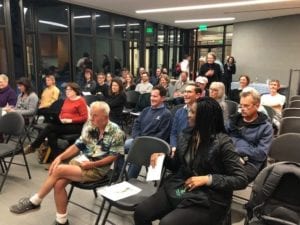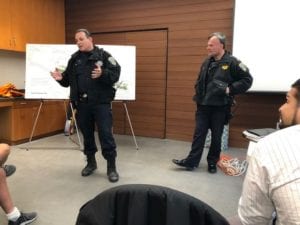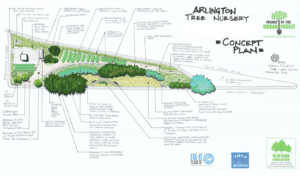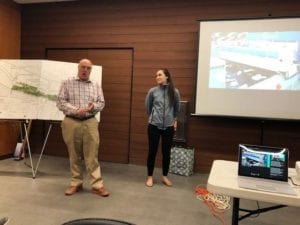
The quarterly meeting took place in the Recreation Center on April 25.
Update on crime and other matters in Glen Park
Captain Hart had just come from a fire safety meeting in Diamond Heights and had some helpful information to share.
There are two separate access points to Glen Canyon Park. The official address is 70 Elk Street, which is the entrance to the playground. The other address is 1499 Bosworth Street, which includes the Glenridge/Silvertree property and the fire pits. People should be aware of this when reporting incidents. Be specific about the location because the dispatch at 1011 Turk Street needs this context to respond effectively.
Recently signs have been posted at the fire pits warning that they are only for use by Silvertree and it is otherwise illegal to build fires in them. If you see an illegal fire there call 911 for police and fire to vet the situation.
Operation Kaboom is the plan the police have for dealing with fireworks on the Fourth of July. Unfortunately, fireworks are set off well in advance, around May 15, and continue until after the holiday. Police will be targeting known perpetrators and putting out warnings on social media.

Officer Luis Tillan, of the Homeless Outreach Team, spoke about the Healthy Streets Operation Center for dispatchers. All involved city agencies work together to coordinate response to homelessness issues. The situation is in crisis: There are an estimated 28 thousand in the Bay Area, with more coming into the state. The Bay Area is third to Los Angeles and New York City in the number of homeless individuals.
There has been some improvement in the situation. When approaching encampments, officers call dispatch to make contacts with a navigation center for a bed. The officer offers to help the individual pack up and be transported to the facility. The majority don’t want to go to the navigation center, or they go and come back to the street in a few weeks. If the person refuses, he can be arrested, their tent and belongings confiscated; SFPW will photograph them and safeguard them for six months. If no bed is available, the person is only admonished.
“I go out of my way to help these people get out of their rut,” said Tillan.
Close to home, Tillan addressed the issue of campers under the Highland and Richland bridges. The Highland bridge area has been fenced off but, for budgetary reasons, not the Richland bridge area. The SFPD is ramping up patrols, and SFPW supervisors have come to assess the issues. They are doing more frequent, smaller cleanups so that conditions do not fester.
In the Q and A, someone asked about cooperation between SFPD and BART police. The new BART area lieutenant, Gina Galetti, and Captain Hart stay in touch via text. There are only three officers assigned from Balboa to Millbrae, with Balboa being the busiest station because of City College.
How to stay current with the crime situation? Captain Hart noted that the Monitor Citizen app is not accurate and not affiliated with law enforcement. Follow SFPD on Twitter and Captain Hart (“Jack from Sunnyside”) on Nextdoor. He’s working with the Glen Park Association to make local crime statistics readily available.
Officer Tillan added, “311 is a beautiful thing. We check updates all day. Don’t get involved [in fighting crime], we’ll do all the work.”
Glen Park Open Spaces

The Street Parks Program is a partnership of SFPW, the SF Parks Alliance and San Francisco residents in which communities transform parcels of city-owned land into places of natural refuge and beauty. Since its inception in 2004, 150 projects have been completed or are in process.
Ramses Alvarez from SFPW, and Doug Wildman, deputy director of Friends of the Urban Forest (FUF), spoke about a project in Glen Park, the Arlington path behind the houses on Arlington Street between Wilder and Roanoke Streets. It’s SFPW property; in addition, there’s a PUC structure on it. For the past couple of years, volunteers, the Fix-It Team, SFPW and the Glen Park Association, have had regularly scheduled work days – clearing fennel and brush, weeding, mulching and picking up trash.
FUF is proposing an ambitious project which would use some of the land as a tree nursery and garden. The nursery would grow approximately 300 street trees in containers (almost 100 per year), which would then be transplanted all over the city. Other landscaping goals are to prune trees; replace, upgrade and relocate fencing; and install connecting walkways.
Maintenance of the land will be done by community volunteers, as is the protocol for these projects, except that FUF will be responsible for the tree nursery and also help with weeding. The SFPW Clean and Green Team will also pitch in.
A lot of funding is needed. SFPW is providing $100K for fencing. In total $300K is needed for fencing – a staggering number. The mayor’s office has allocated another $100K. The rest will need to come from private fundraising and grants. Wildman said they’re ready to go with their plans, but processes need to play out for approvals and community input.
For information about SF street parks, click here.
Recology update on recycling in S.F.
Amid environmental crisis, say Noelle Duang and Paul Giusti of Recology, we need to work harder to protect the oceans and the planet. San Francisco continues to increase the rate of recycling, producing the cleanest bales possible with more complex technology, such as optical sorters. They’ve invested $14 million in upgrades at their facility at Pier 96. At the same time there are challenges, such as China now refusing to purchase eighty percent of our recyclables, and the material itself losing value.

The recent adjustments to the bin sizes have been very successful. San Francisco residents are passionate about the new program to reduce landfill.
As the types of material that is recyclable increases, which is a very good thing, confusion grows about what goes where: In addition to bottles, hard plastic and cans, fiber and film plastic are now recyclable when placed in plastic bags. Paper labels on plastic are OK. Milk cartons too. Rinse food off before recycling so the material doesn’t contaminate the load.
For what goes where, go to Find the Right Bin here.
Greenway Project progress report
Project Manager Nicholas Dewar gave a shoutout to the recent rainy season, which provided a big boost to the plantings at the Greenway. He also hailed the volunteers who put in 1700 hours of work over sixteen months.
The tree planting is completed. Seventeen saplings of coastal oaks and silk tassels were planted across the three parcels. Thirty-six local acorns from Golden Gate park were also planted. Biologically it’s much healthier to grow from acorns, as the trees develop healthier root systems when they are developed in situ. The new native shrubs and raised display beds are blooming, providing habitat for birds and bees.
With fanfare, new signage was unveiled at the Brompton Street entrance.
The first water meter has come online. For the past two years a neighbor has generously donated use of his residential water to get the plantings established before the Greenway water supply was available.
The next step is the trail itself, from Brompton to Lippard and Lippard to Chilton. A topographical survey and preliminary designs have been done. This year will be heavy on fundraising with construction starting next year. It will probably be aggregate material — firm underfoot yet water permeable. Also on the way is a new plot that will be tended by the garden club.